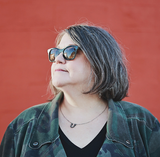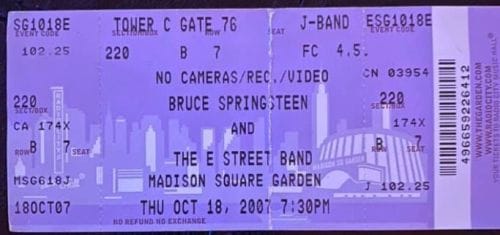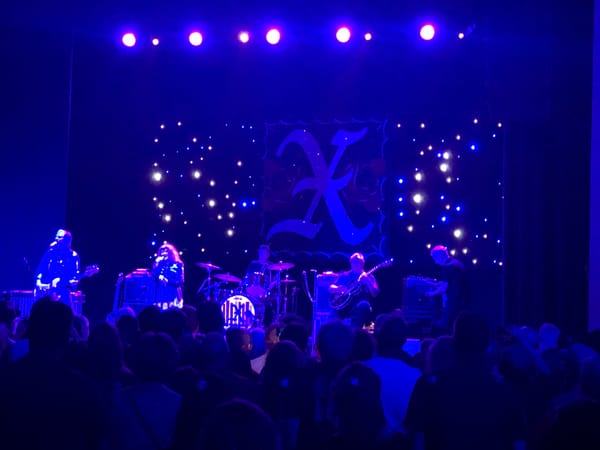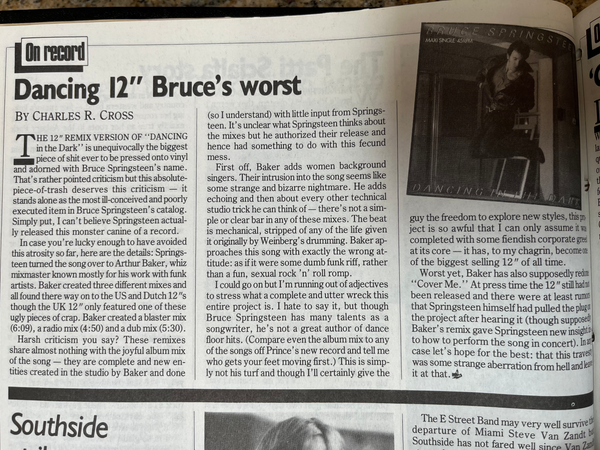Homecoming Queen: Madonna in Detroit, January 15, 2024
We're Ciccone Youth from New York City
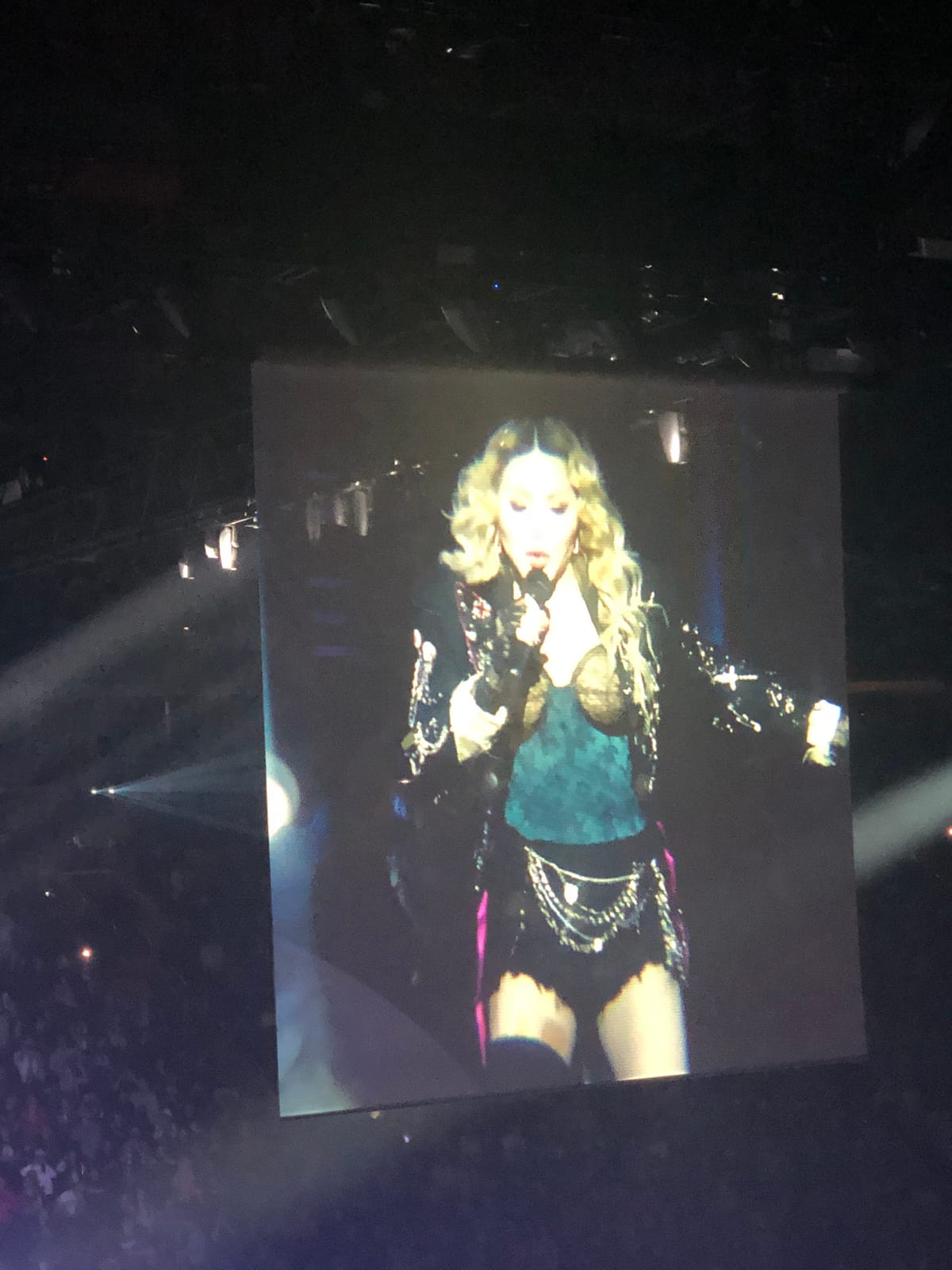
I carpooled to Monday night’s show with two friends who are veterans of the Detroit punk scene. When I was reminiscing about early Madonna in NYC and the days we’d go down to Canal Street to visit the plumbing supply shops and buy the rubber gasket bracelets that she made so popular in the 80s, one of them commented that she wasn’t listening to Madonna then, because it wasn’t her music, and we drew fairly rigid lines back then. This made me start retracing my allegiance to her in my head.
For some reason (and not for the reason Madge spotlit in the show, but we’ll get there) we accepted her as extended family. It was because she was playing in the same places we hung out, like the Pyramid or Danceteria, because she shopped at the same places we did, like Unique Boutique or Canal Jean or the thrift stores east of Second Avenue. I was past my ‘disco sucks’ attitude by 1982 and I liked to go out and dance with my girlfriends. I went to college in Manhattan and it was a commuter school so I was with kids from all of the boroughs and had girlfriends from Queens who dragged me with them to the Paradise Garage. I wasn’t some kind of special flower, there were plenty of folks who both accepted her and (I am now ashamed to admit) both admired her hustle but also constantly slut-shamed her: of course there’s no way a woman is going to be that successful that fast (it wasn’t fast) without fucking her way through it. The 80s were all kinds of messed up.

It was approximately -20 degrees Monday night so I gave up trying to look super-cute and just threw on leopard print. But I admired the folks wearing sequins and especially loved the women who broke out their tulle and made tutus and hair bows and did the full Like a Virgin hair, which I could have tried to do had I not been more concerned with not getting frostbite on the three minute walk from the parking lot to the entrance to Little Caesar’s Arena.
Editor’s Note: LCA has a no-bag bag policy and I am already bringing nothing to this venue as a result and yet I had to be stopped in the vestibule with the arcticwind blowing so that security could make me open my tiny envelope of a bag, never mind that I could have snuck in contraband (whatever they think they were going to find by making me open this tiny stupid bag) in any of my pockets, because they didn’t check those! It is so dumb.
When I got to my seat around 10pm, the woman sitting next to me was napping across it. She sighed and moved her jacket. “I knew someone was gonna be sitting in seat 1.” They were some of the few people who didn’t seem to know that Madonna goes on late. Once I explained it I overheard her on a FaceTime with her daughter, complaining, “No she has not started yet. She pulling a damn Beyoncé.” A friend — who is actually legitimately related to the Material Girl — texted me saying that her friend on the crew said Madonna was starting at 10pm.
It was at 10:30 that Bob the Drag Queen walked onto the floor and announced that the show was starting. I was afraid for a minute that they meant that their part of the show was starting and Madonna was still somewhere on the horizon. Bob announced the hometown girl, that there would be some of Madge’s exes and some babysitters in the audience. They then continued with their high-level summary of Madonna’s career, which was annoying for half a second because I just wanted the music to start already — until I realized that all that was happening was an updated 2024 version of the introductions on the 50s & 60s rhythm and blues revues:
Are you ready for Star Time? Please welcome to the stage, the hardest working man in show business, the amazing Mr. Please Please Please, the star of the show, Mr. James Brown.
It’s the same thing, it’s exactly the same thing. It is the action of an artist who is not letting someone else define who they are and what their accomplishments have been; only they get do that. If that was the only thing Madonna accomplished in this show, it would be important. She has never gotten a fair deal while she was alive and working, she won’t get one later, she knows this, she’s always owned it, she’s not going to stop.
There are four acts to the show, and it runs in chronological order. So after the Queen makes her grand entrance to “Nothing Really Matters,” the next handful of songs takes you (okay, me) back to the Lower East Side in the early 80’s. “Everybody” and “Into the Groove” and “Burning Up” are so place-specific, I was not expecting to be sitting in section 126 silently weeping while making sure I did not fall down the stairs while shaking my ass. I know these songs!
Madonna! No one ever says “Welcome to the New York Subway.” Come on, girlfriend.
The pacing of this show is outstanding. It is kinetic and engrossing and modern, but there are cleverly integrated pauses where Madonna gets to stop and stand and catch her breath. She’s not moving from song to song without engaging with the audience, she does three-four carefully choreographed numbers and while the dancers go off for a costume change she drinks some water raps with the audience. That part isn’t scripted; I didn’t see a prompter anywhere but that doesn’t mean there isn’t one, and even if there is, that’s not a diss, it’s a tool an artist can use well or not. I’m not grading musicians on their memories, I care about the performance, and if the prompter helps with that, go for it.
“I’ve got so much adrenaline pumping through my veins,” she insisted, because she was home! In Detroit! She is telling us the stories of her life. She is explaining how her father didn’t help her when she left because he wanted her to try and fail so she’d come back home. And she walks a very fine line where she thanks Detroit “for pushing me...in the right direction” and not “thank you for sucking so much that it made me leave.” It’s like the song “Small Town” from the Lou Reed/John Cale piece about Warhol, Songs for Drella. “There’s only one good use for a small town/You hate it and you know you’ll have to leave.”1
One of the dancers is out on the catwalk with her, and Maddy explains that it’s meant to represent her, 40 years ago. And it’s emotional for her to interact with them, and I think about how powerful it would be if we could all talk to our younger selves, reassure them, thank them. She’s giving herself both forgiveness and permission. She’s still dealing with the enormity of being Madonna and it’s healthier to be doing this than it is to be self-medicating yourself over it so you don’t have to feel it.
Silvio Ciccone is in the house; he’s 92 years old. Madonna tells us how hard her father worked, that they fought when she was a teenager but he taught her about working hard. My brain of course shoots a flaming arrow from this action to every story Bruce Springsteen ever told about his dad. Women mostly don’t do this, but that is more of a reason for her to be doing it. If women had better relationships with their fathers and vice versa we would all need a lot less therapy! But she’s teary, it’s not scripted, it probably follows things she’s said before but it is a raw and genuine moment — one of many — in this show of revolving stages and a million costume changes and pyro and flying cages.
But she must not have thought she’d gotten sufficient audience response because she pauses: “I’m telling you the story of my life, are you with me?!” My sister in Christ it is 10:50pm and you got onstage 20 minutes ago, most of us are in your age cohort, it’s a Monday night, if you want more energy from the audience then consider starting the show closer to ticket time!2
It was in one of those moments that she talks about how hard she worked (true), how she came to New York with $35 (also true) and that the pivotal moment for her was when she learned to play guitar, so she could start writing her own songs. And then she straps on a black Les Paul and insists that she played this song at CBGB’s, performing “Burning Up” where the focus is on the guitar licks that are the undercurrent on the 7” and not the synth-laden delight that is any of the remixes that most of us know the song from.
NO! Girlfriend, this did not HAPPEN, not like this. You were on that stage maybe once with the Breakfast Club and you were the drummer! Maybe, yes, someone let you play guitar on one song. But this is an era I was actually walking the same streets as you and if anyone asked me what NYC clubs Madonna was associated with, the first thing I’d say is Danceteria. That was your hang, not 315 Bowery! I understand that CBGB as a brand is more well-known than Danceteria to most of the world, but you are Madonna and you do not need to name-drop CB’s for any kind of credibility.
From a practical standpoint I understand, she wanted to do the song and tell a story about her early days in New York, and she had just done three elaborate production numbers and didn’t want to be out doing another one for “Burning Up.” But it is one of my favorite Madonna songs and I was certain we would not hear it because it is such a basic (but really great) song compared to everything else from that era. It will always be that moment in the club when it came on and you ran out on the dance floor with your girlfriends and just shook it for three and a half minutes.
The “Erotica”/“Justify My Love” segment is high art. I love that she still doesn’t GAF about pissing off the Catholic Church. She doesn’t have to keep doing this but I also do not have any comprehension of what it was like to grow up in a Catholic household and how intensely the urge to push back or resist or defy is, and how it never leaves you. I love any artist who is realizing their vision in 2024, especially if it’s guaranteed to deeply rankle any purveyor of so-called morality or puritanism. It’s a rotating carousel of crosses within which the dancers, either mostly nude or wearing body stockings that create the illusion of nudity, while also wearing gimp masks.
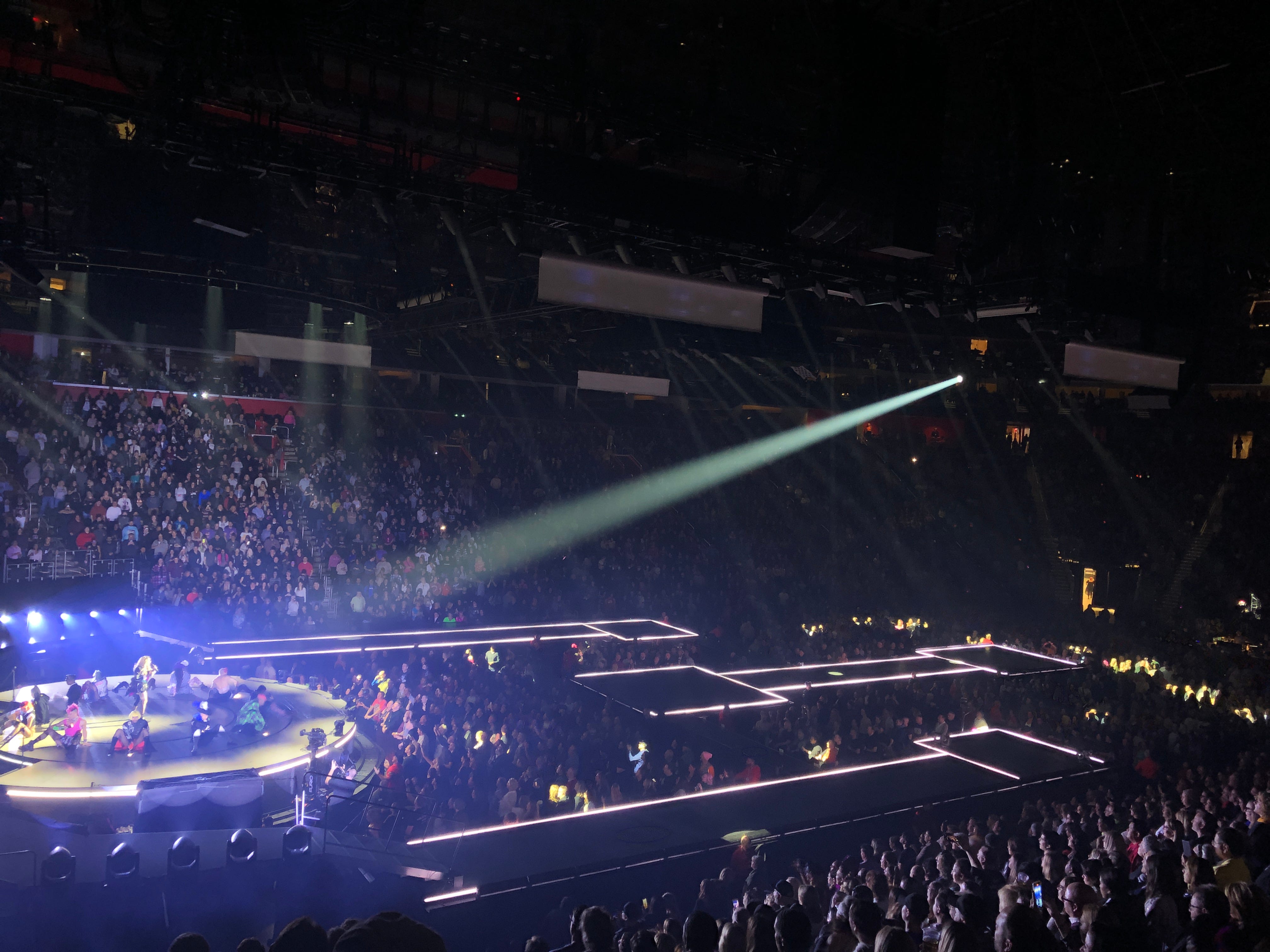
This is the first large non-traditional arena-level stage that I felt was successful at multiple levels. It is “inspired” by the Manhattan street grid. (I will refer you to this fantastic map created by the folks over at the MadonnaTribe fan site for better detail.) There’s a main stage, which is round and has various hydraulic platforms that lift and rotate, and there’s an audience area with chairs directly in front of it. But that’s about as normal as it gets. The rest of the stage is an extending catwalk that intersects and meets at larger b-stage spaces out on the floor. And unlike a lot of artists who use a b-stage concept, this show utilizes every single inch of the space throughout the entire night. It isn’t “two songs on the b-stage, yay” nor is it confined to the star coming down to a platform to perform a song. There were boxing rings, the bed from the Blonde Ambition tour made a cameo on one, there’s a Voguing contest on another. There is also an illuminated box that flies above the audience from the main stage out to the farthest platform which I did not like and did not think Madonna holding on tightly to a rail was sufficient, although folks who were closer assured me she was strapped in tight.
There are also video screens at the back of the mainstage (and if you have a side view you will not see them) and then ancillary screens on both sides of the arena that unobtrusively raise up and down in different dimensions: if the ensemble is on the main stage, they can drop all the way down to the catwalk; when the troupe headed out again, they disappeared up into the rigging. I am fanatic about not spending my time at a concert watching a video screen, but here you have to or you will miss things.
But the way they are inserted into the production, and the fact that the stage extends out fully into 80% of the floor, does a lot to address that and you don’t feel like you’re home watching television. I did not find that it detracted from my experience, I was just annoyed that I didn’t know that the screen at the back of the stage was going to be completely inaccessible to me and anyone who sat to my left. Yes, the tickets said “side view” but that is not “you cannot see this screen for the entirety of the produc- tion,” accompanied by a price tag that reflected that.
There were some fun, unironic, circular/meta moments where you look at Madonna and think “that’s Gaga” or “That’s Ariana” or “That’s Britney” but, I mean, they’d be the first to admit that is exactly what they were doing, so for her to use the visuals as a device and nod to that is generous and flattering. These were all happening during performance numbers and it just gave people who noticed something to think about.
What I didn’t understand were the moments in the show in tribute to Prince and then later, to Michael Jackson. These were transitional moments that were taped, not live, with many of the performers offstage — I understand the utility of the concept, but it felt oddly out of proportion in an evening that’s about celebrating your work and life and accomplishments. I am not sure I comprehend why Evita or Dick Tracey got less stage time than MJ and Prince. These are the pop musicians who were in the chart with her at the peak of Madonna-mania and there is a lot of tribute tonight to entire generations of artists who are no longer here. There was not, for me, enough of a connection made to understand why this was being presented to us.
Performance tradeoffs I struggle with: the use of remix versions and shortened versions of songs. “Crazy For You, “La Isla Bonita,” and “Don’t Cry For Me Argentina,” for example, are shorter, and the audience really wanted to sing “La Isla Bonita.” But “Vogue” was its large and glorious self on the mainstage, carefully choreographed, Madge in sparkly silver high heels that made me pull a muscle just looking at them. She played “Express Yourself” solo on acoustic guitar and it ruled. And “Bad Girl” was Madonna and her daughter Mercy James on the grand piano in the middle of the arena, and if the trade-off on a shorter version of an earlier song lets you have this stunning moment, I’ll take it.
Towards the end of the night, some fans at the very end of the longest runway held up a sign, and just when one might be rolling their eyes at this gesture, Madonna commented on it, telling us it read HOMETOWN HERO. “I like that sign,” she said, “This is where I’m from - when I come home the stress level goes up to here. I care about what you think, I want you to be proud of me.” She’s not faking any of this. It’s astounding that it is true, but it is fantastic that she’s admitting to it in front of all of us.
The last number is the 2015 collab with Nicki Minaj, “Bitch I’m Madonna” and at first my reaction was, “With your entire catalog, this is what you want people to walk out with in their head?” But this is her show, this is a woman defining her history and her legacy. She makes a point to say the same thing at the end of every show, that to get old is a sin, and that the most controversial thing she’s ever done is stick around. As she reminded us earlier in the show, she almost died; after that, she could have packed it all in and never graced a stage again and nothing would have changed about her contribution to the cosmos. She literally does want us all to remember that bitch, she’s Madonna.
They are obviously not the only people who have written songs about leaving small towns, I just watched it over the holiday so it’s top of mind, and also the connection between Madonna and Warhol isn’t just a dotted line. ↩
I would love to know why these shows are starting so late and why they are not just being up front with the people who are spending a not- inconsiderable amount of money in this economy (and who held onto the tickets or a year!) You don’t have to give an exact time, but you can say “Madonna takes the stage at 10pm or later.” It’s just good manners. steps off soapbox (I yelled at Bruce too) ↩
